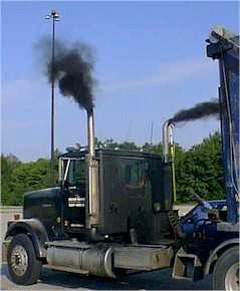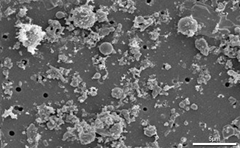Getting Particular About Particulates
Air Date: Week of February 9, 2007

Diesel truck (Courtesy of Maine Department of Environmental Protection)
A new study looks at the link between tiny particulate air pollution and cardiovascular disease. The study of more than 65,000 post-menopausal women shows that longterm exposure to these pollutants dramatically increased the incidence of cardiovascular death. Host Steve Curwood talks with Dr. C. Arden Pope, an epidemiologist and economist at Brigham Young University.
Transcript
CURWOOD: From the Jennifer and Ted Stanley Studios in Somerville, Massachusetts, this is Living on Earth. I’m Steve Curwood. You may instinctively cover your nose and hold your breath when a diesel motor belches a black cloud in your direction, but it turns out that it’s what you can’t see that’s most harmful. Scientists have known for years that it’s the tiniest invisible particles in soot and exhaust that can cause the most harm. In the 1990’s Harvard researchers calculated that as many as 70,000 Americans die prematurely every year from tiny particle pollution, mostly from diesel engines and coal-fired power plants.
And now the New England Journal of Medicine has published a study out of the University of Washington of 66,000 postmenopausal women that indicates the death rate may be even higher. In some of America’s cities with the dirtiest air, such as Pittsburgh, Cincinnati, and the Los Angeles basin, this latest study indicates the risk of death from cardio-vascular disease for those women is close to that of active smokers.
CURWOOD: Dr. C. Arden Pope is an epidemiologist and economist at Brigham Young University in Utah who studies particulate pollution. Dr. Pope thanks for joining us.
POPE: Thank you.
CURWOOD: Perhaps we should start with a little lesson on particulate size. Why does size matter when we’re talking about particulate air pollution especially in relation to this study?
POPE: Well there’s two reasons that size matters. First, is that course particles, particles that are relatively large, are often naturally-occurring. They come from wind blown dust and other natural sources. These particles do not seem to be especially toxic. That’s because chemically they’re different. It’s also because they’re of a size that do not penetrate deeply into the lungs. Fine particles, particles less than two and a half micrometers in diameter are much more serious. And the reason is they’re chemically more toxic. They come primarily from combustion processes. Furthermore their size is such that they can be breathed deeply into the lungs and therefore cause more problems.

"A magnified view of aerosol particles collected in the industrial city of Port Talbot, England. Many of the particles measure roughly 2.5 microns across, small enough to easily enter and damage human lungs." (Courtesy of NASA/MRC Institute for Environment and Health)
POPE: What’s new about this study is two things. One is it focuses primarily on women; postmenopausal women. And two, it observes effects that are substantially larger than have been observed in previous studies. There have been two other studies that have looked at cardiovascular death in both men and women: the Harvard Six City Study and the American Cancer Society study. And both of these studies did observe that cardiovascular death, or at least the risk of cardiovascular death, was increased with long-term exposure to fine particle pollution. This study focused on women, and not only observed that the risk of cardiovascular death is increased with exposure, but that increase risk is substantially higher than what was observed in the previous studies. The difference is roughly two to three times higher than what we had estimated earlier.

Diesel truck (Courtesy of Maine Department of Environmental Protection)
CURWOOD: Can you break that down for me?
POPE: Basically what they did is they followed up postmenopausal women that did not have cardiovascular disease and then over a period of approximately six years they looked at which women developed cardiovascular disease and which women died of cardiovascular disease. What they learned is that individuals exposed to ten micrograms per meter of pm2.5 had a 24 percent increased risk of having cardiovascular events and a 76 percent increased risk of dying from cardiovascular disease. Interestingly enough, they also looked at cerebral vascular events.

C. Arden Pope is the Mary Lou Fulton Professor of Economics at Brigham Young University (Photo: Brigham Young University)
CURWOOD: Strokes you mean.
POPE: Basically strokes. Basically ischemic strokes but uh, it was amazing that even ischemic strokes or these cerebral vascular events, were associated with increased levels of pm 2.5. And in fact for every 10 microgram per cubic meter increase in pm 2.5, there was about a 35 percent increase in these cerebral vascular events or primarily strokes.
CURWOOD: Now the current EPA limit for fine particles in the air on a long-term basis- I believe- is 15 micrograms per cubic meter. What does this study say to you about that limit?
POPE: Well, this study as well as numerous other studies, seems to suggest that the exposure-response relationship between air pollution and cardiovascular and respiratory disease is near linear. That is to say there’s no clear threshold where exposure to air pollution is strictly safe. And so that is a bit troubling on the one hand because it suggests that even air pollution below 15 micrograms per cubic meter can have impacts on our health. It’s good news also, in the sense though, that if we make efforts to improve our air quality even at levels below 15 micrograms per meter we will get improvements in health. So it suggests that the standard itself is not strictly protective of everybody in terms of exposure.
CURWOOD: Dr. Pope thank you so much.
POPE: You’re welcome.
CURWOOD: Dr. C. Arden Pope is an epidemiologist and economist at Brigham Young University in Utah. He spoke to us about the Women’s Health Initiative study on fine particulates, published in the recent issue of the New England Journal of Medicine.
The issue also includes editorial comments from Dr. Douglas Dockery, at the Harvard School of Public Health, who was one of the authors of the original Harvard Six Cities Study. To get more details and hear an interview with Dr. Dockery, go to our website, loe dot org.
Links
Living on Earth wants to hear from you!
Living on Earth
62 Calef Highway, Suite 212
Lee, NH 03861
Telephone: 617-287-4121
E-mail: comments@loe.org
Newsletter [Click here]
Donate to Living on Earth!
Living on Earth is an independent media program and relies entirely on contributions from listeners and institutions supporting public service. Please donate now to preserve an independent environmental voice.
NewsletterLiving on Earth offers a weekly delivery of the show's rundown to your mailbox. Sign up for our newsletter today!
 Sailors For The Sea: Be the change you want to sea.
Sailors For The Sea: Be the change you want to sea.
 The Grantham Foundation for the Protection of the Environment: Committed to protecting and improving the health of the global environment.
The Grantham Foundation for the Protection of the Environment: Committed to protecting and improving the health of the global environment.
 Contribute to Living on Earth and receive, as our gift to you, an archival print of one of Mark Seth Lender's extraordinary wildlife photographs. Follow the link to see Mark's current collection of photographs.
Contribute to Living on Earth and receive, as our gift to you, an archival print of one of Mark Seth Lender's extraordinary wildlife photographs. Follow the link to see Mark's current collection of photographs.
 Buy a signed copy of Mark Seth Lender's book Smeagull the Seagull & support Living on Earth
Buy a signed copy of Mark Seth Lender's book Smeagull the Seagull & support Living on Earth

